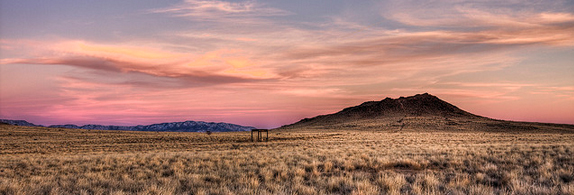Later Bloomers and the 75 Deadline

If Dr. Ezekiel J. Emanuel were an advocate of euthanasia and physician-assisted suicide, I’d be little more worried than peeved at his article in The Atlantic this month suggesting that 75 is a good age for dying – at least to him. But he is a long time passionate opponent of such potential mercies, largely because of a version of the precautionary principle. Outlawing such humanitarian gestures prevents potential abuse, or so his reasoning goes.
Emanuel’s Atlantic essay equates the “good life” with the young life. He apparently sees nothing but pain and distress in getting older. For him increased compassion, creativity, responsibility, patience, and even wisdom – are bundled up and hidden in the closet of gerontological decline.
Tell that to the some 275,000 New Mexicans who are over 65, including me. That’s some 13.6 percent of our state’s population. For those of us who are in good health with work to do and love in our lives, Dr. Emanuel’s essay seems like a rank publicity stunt – sensational and hollow.
It reminds me of a document dreamed up by a second tier science fiction writer who’s invented a world in which old people are duped into thinking they’re serving society and becoming humanitarian heroes by agreeing to sacrifice themselves for the good of all at, say, 75 years of age. And those who don’t? Well, sic the dogs on them.
But, of course, in this science fiction tale only the rebels will refuse. The rest will present themselves at Heaven’s Gate on their 75th birthday, turn over their assets to their families and the state, be prematurely eulogized, crowned with Hawaiian flowers, and taken behind a curtain where a cattle spike whams into their brains.
Dr. Emanuel would never make such suggestions outright. But his rhetoric is full of the bombast and easy stereotyping of someone who has bought into America’s Cult of Youth. He seems to me to be a kind of unwitting prophet of a potential social horror that the Ageist bias of consumer culture has set to percolating in the American collective unconscious. As times get tougher and the false economy of the marketplace and the real economy of the environment both go against large populations of human beings, particularly older ones, Emanuel’s cut off date calculated by “whether our consumption is worth our contribution,” has the ring of filling up buses with the elderly, putting a hose from the tail pipe into the passenger section and waiting until the old folks nod off and perish.
After waxing on about the inherent infirmities, disabilities, inadequacies, incompetencies, and general dimming and fading of the elderly, Emanuel ends his essay with a convenient golden parachute by saying “I retain the right to change my mind and offer a vigorous and reasoned defense of living as long as possible. That, after all, would mean still being creative after 75.” Creative by whose terms?
The whole thing is a silly waste of thought. I really can’t understand why the editors of The Atlantic chose to publish it. The generous side of me thinks, “No it wasn’t just rank salesmanship. Maybe they wanted to stimulate thought.” Maybe they have a secret grudge against Emanuel and were eager to help him to make himself look like a fool in print.
Granted, Emanuel isn’t advocating a mandatory exit age. But he does paint an immobilizingly depressing picture of what it means to live on “past your prime,” live on past the age when consumerism is no longer of interest, past the time when people start worrying if they should be looking out for you or after you.
Examples of fully realized lives after 75 abound. But usually the joys and contributions of such lives don’t have much to do with the materialistic scale of consumption and contribution.
Can anyone quantify the inheritance of strength that might come from a short, intimate conversation between a child and a grandparent about a human problem of great complexity, or the strength that love bestows upon the young coming as unconditional acceptance and admiration from an older member of a family? That bond of love and its empowerment across the spectrum of life’s experiences is of more subjective value than any health care calculations.
Without the full range of human experiences available by example to most families, young people would not have an inner map of the human trajectory of time, nor would they be able to take in the priceless insight into the value of being wise and kind, as opposed to the advantage of being young and ambitious. In New Mexico the contribution of elders is the basis of the wisdom resources of many cultures. To see them toddle off like lemmings would stunt the growth of communities every bit as much as cutting off the top of a tree stunts and deforms its growth.
Not all old people are wise, of course. But where would we be without the ones who are?
I’m sure there’s a rather sizable class of people of all cultures and social status known as late bloomers who would find Emanuel’s essay just plain foolhardy.
Late bloomers are being tested out of their futures at a young age in many schools in New Mexico and around the country because they don’t conform to the consumer stereotypes of market driven corporate educators. Kids get stopped because they aren’t good test takers or because they may be somewhat slow at a certain age, but really start to flower vigorously later on. What a tragic waste to rein in and discourage people with latent talents before they even have a chance to begin. And what a tragedy it would be if older late bloomers were cut short by ageist bias just as they were flowering at last.
For some of us, and I think I’m one of them, our “later years” are our most productive, our most satisfying, and perhaps the years we are most useful and helpful to others.
I could still be here in l8 years when Dr. Emanuel reaches 75, changes his mind and writes his “vigorous and reasoned defense of living as long as possible.” And if he does, I’ll probably argue with him. It’s not living as long as possible. It’s living as deeply, as fully, as fearlessly, and as gratefully as possible. And age doesn’t really have much to do with it.
The Crime Against Humanity and All Living Species

As I drive long miles around Albuquerque and New Mexico to do the work I have to do, I wonder increasingly, and with growing irritation, why I’m not able to drive a hydrogen fueled automobile, or an electric car fueled by taking power from the grid, power that comes more and more every day from solar and wind power, or why the Four Corners area has the dirtiest rural air in America, or why our entire way of life here depends on energy from coal, natural gas and other greenhouse polluters, why an enormous methane cloud spews from the ground in the heavily drilled and pumped San Juan Basin, why our economic viability as a nation, and my family’s viability as chump change investors depend on products that are slowly killing us off.
This train of thought went through my head the other day after I had read the latest issue of Green Fire Times which has as its subtitle “News and Views from the Sustainable Southwest.” Such thinking, I admit, is always with me, but the October issue of Green Fire, with articles on “The Promise and Challenge of Renewable Energy, triggered off with renewed intensity a mental chain reaction of questions that have become unavoidable.
It’s tempting to become hyperbolic as the reality of climate change and its causes sinks deeper into consciousness. The forces that deny and debunk what is so obvious to so many of us gloat and preen and pitch PR as they profit obscenely from extracting and selling an atmospheric poison that only they deny is harmful.
Are these climate change denying energy privateers committing crimes against humanity and all other species, environmental crimes that endanger the lives of billions of human beings and the extinction of countless other species because they have the power and the money to manipulate economic “reality” to their overwhelming advantage? Is there a good chance that politicians supported by them could take control of the House of Representatives in New Mexico and even the Senate of the United States next month?
Part of me wants to say it’s not as easy as that. Or I hope it’s not as easy as that. But another part of me knows that it is.
And what’s more frustrating than anything else is that in so many ways climate change is a manufactured menace, the creation of companies and their PR lobbyists who have set about to oppose scientific consensus and personal common sense as well as deflect attention from and, in many cases, purposefully quash, viable competitive alternatives to their products and way of life.
This is how the marketplace works. Might makes right. More money kills off lesser money. But it’s not just a metaphoric battlefield for riches. It always leaves the realm of financial fantasy and theory and morphs into propaganda in the guise of fact and opinion. Anyone who opposes such economic bullying is to be applauded and supported.
As climate change dries up our agriculture, kills off our trees, and threatens our cities with megadroughts, New Mexico is graced with a vast potential of wind and solar power, enough to slowly change the course of climate history by replacing our use of greenhouse gasses completely.
The October issue of Green Fire Times, published in Santa Fe by Skip Whitson and edited by Seth Rothman, has major pieces on the New Mexico Public Regulation Commission (NMPRC) and its role in the state’s energy future, the renewable energy Genius Grid, and such things as the actual damage of wind and solar power to wildlife. The Green Fire Times is always worth reading, but this issue particularly puts many of our energy dilemmas in perspective. You can find it online at greenfiretimes.com.
Propaganda undercutting data about the dangers to wildlife from cities and from energy production appears in a piece by author and photographer Jamey Stillings from his TEDxABQ talk on September 6, 2014. “A recent study,” he says, “estimated that bird deaths per gigawatt hour of electricity are 17 times higher for fossil-fuel energy than for wind power.” It’s never seemed plausible that big wind turbines are a major source of bird death. Turns out they are not. Stillings writes that some “600 million birds die each year in the United States by hitting buildings and houses, and nearly eight million die from coal power production.” That eight million birds, if you recall, is 17 times higher than birds killed by wind turbines.
A piece by Bianca Sophoci-Belknap on the NMPRC’s role in deciding what kind of “replacement” power will be used to replace the EPA mandated shutdown of two coal powered units at the San Juan Generating Station helps readers understand what a pivotal moment in the state’s energy history this Fall could be – if the PRC recommends a dramatic increase in renewable energy as replacement fuel.
People all over the west – from parched California to baking Arizona, Nevada and New Mexico – know that climate change is not a joke. If the Sierra Nevada doesn’t get a significant snow pack this winter, Southern California could see stringent water rationing as early as next summer. And if the Colorado River watershed doesn’t get a powerful load of snow, Lake Mead could fall so low as to no longer be able to produce hydro-electric power for Southern California and could cause a drastic curtailment of Colorado River water to Phoenix and Tucson.
Denying climate change, and making a fortune from extracting, selling, and using the resources that produce it, is really ultra slick political and economic bunko, a deadly swindle, a crime against us all, even those who profit from it in the short run. There’s no place to run to in an overheating world.
Why We Love New Mexico – The Gift of Perspective

A largely by now unknown group of activists, who performed a kind of political heroism in the l970s, have given Albuquerque the gift of perspective. And what a gift it is, helping us to see beyond the harried limitations and claustrophobia inherent in urban living.
Activism, especially the environmental kind, can often be a truly thankless and exhausting undertaking. But from time to time the results for future generations are worth the frustrations and despairing doubts. When you look west and see the volcanoes on Ceja Mesa, or when you take in the view from the Elena Gallegos Open Space area in the foothills of the Sandias, the head-clearing panoramas of this amazing oasis of the Middle Rio Grande Valley appear before you like a vision of liberty.
The West Mesa Volcanoes are a gift to us from an amazing woman, Ruth Eisenberg, a self-described little old lady in tennis shoes who, when most people are settling back into retirement, took on the Albuquerque establishment to save the volcanoes and their escarpment, or Ceja, from the depredations of developers. It was a monumental undertaking.
Westside growth was just beginning to jump start the Albuquerque housing market after a slump in the late l960s. Few in the Albuquerque business community were thinking about setting aside prime land with magnificent views for the betterment and enjoyment of the public. By l971, the Albuquerque City Commission had been persuaded by Ruth and a small army of others, including citizens who served on a City/County Goals Commission, had persuaded the business community and the elected leadership to, in effect, create a new kind of commons, a “view shed” commons that served not only as a psychological and aesthetic relief for city dwellers, but also as symbols of the city’s best and wisest intentions to create a place that was not only prosperous but inspiring.
Along with the preservation of the volcanoes, those icons of Ruth Eisenberg’s forward thinking about Albuquerque’s sense of place, the Elena Gallegos open space was set aside largely because of the organizing acumen and insistence of Phillip Tollefsrud and the Citizens Open Space Task Force. The Elena Gallegos is a 640 acre wilderness park with one of the most spectacular views in America and hiking trails that take you into the mountains and away from the madding crowd in less than half an hour.
That perspective from the Elena Gallegos is available to everyone for a few dollars most days of the week. Late October at twilight is a favorite time to be there. The city, river and volcanoes are spread out below. Beyond them is majestic Mount Taylor. To the north, one can see the top of Cabezon, the great volcanic plug in the Rio Puerco Valley, and to the south are the Ladrones and the Magdalena mountains.
And everywhere you look, the Rio Grande runs its course, full or sparse, still nurturing life in the valley. When the sun sets behind the western horizon and night begins to fill the world below with shadows and peace, Albuquerque appears as it really is – a ribbon of lights contained within an immensity of darkness that no amount of development can invade and conquer – not so far at least.
We owe so much to those citizens more than forty years ago who loved Albuquerque and the land it occupies so much they were willing to spend countless hours in the political trenches to get the impossible accomplished. Imagine what it took to preserve land for the public good in a place that was sprawling for private profit virtually without any restraints. It’s a miracle, really. And every time I’m walking acequia banks in the North Valley and look across the fields to the West Mesa and see the “J” volcano, with the J finally fading away, I think of what that priceless view might have looked like covered over with roads and subdivisions. Those volcanic cones are made even more beautiful by the knowledge that they are also symbols of the good works achieved by political persistence in the service of a common goal, preserving the empowerment and solace of natural beauty in an urban world that all too often measures its success by money and little else.
(Photos: Older couple by Tommy Hemmert Olesen, West Mesa Volcano by Jeremy Taylor / CC)

October 19, 2014